- Author: Kathy Keatley Garvey
If you're interested in pollen and pollinators, you'll want to attend the UC Davis Department of Entomology seminar at 12:10 p.m., Wednesday, Feb. 1 in 122 Briggs Hall.
That's when T’ai Roulston, research associate professor and curator, State Arboretum of Virginia, will speak on "Pollen as a Resource for Pollinators: What Governs Quality?"
Pollen is a bee's protein. Nectar is a bee's sugar or carbohydrate.
T'ai Roulston will be speaking specifically on pollen. "Lab work using the sweat bee Lasioglossum zephyrum has shown that protein concentration of pollen may dramatically influence offspring size," he says.
"T'ai's work on native bees and insect-plant interactions includes pollination biology, foraging ecology, nesting biology, life-history as well as some work on multi-trophic interactions," said host Neal Williams, assistant professor. (Williams is currently in Japan to present a lecture at the International Symposium on Pollinator Conservation, set Jan. 27-29 in Fukuoka.)
Roulston says on his website:
"My primary research area is plant-pollinator interactions, which I study through field and laboratory approaches." These include
1. Studies of pollen chemistry, particularly protein, to characterize the diversity of pollen nutrient rewards and their effects on pollinator host plant choice and larval development;
2. Specialization/Generalization in plant-pollinator interactions
Other research areas include endangered species conservation, habitat fragmentation, foraging behavior and nestmate recognition in social Hymenoptera, and the impact of exotic species on native organisms.
Coordinating the UC Davis Department of Entomology winter seminar series are assistant professors Louie Yang and Joanna Chiu.
If you can't make it to the the lecture, Professor James R. Carey plans to video-record it. It will be posted in about two weeks on UCTV.
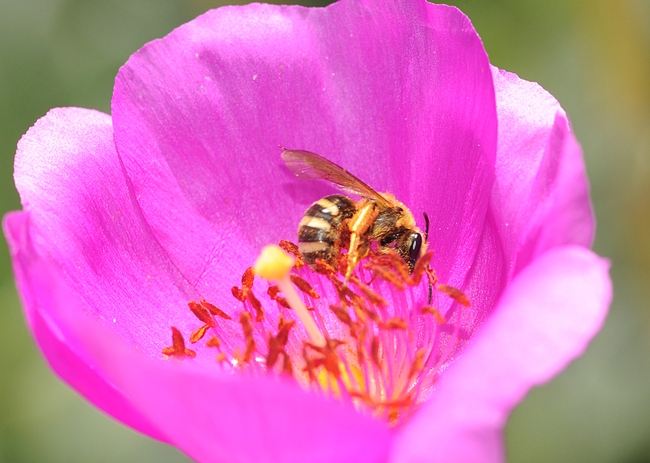
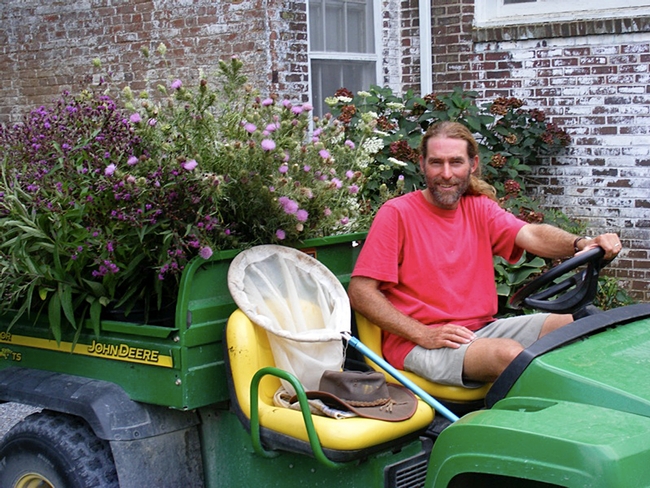
- Author: Kathy Keatley Garvey
Bring on the asters.
When you visit the Häagen-Dazs Honey Bee Haven at the Harry H. Laidlaw Jr. Honey Bee Research Facility at the University of California, Davis, you'll see Donna Billick's six-foot-long bee sculpture, Miss Bee Haven, "nectaring" a ceramic purple dome aster (Symphyotrichum novae-angliae).
Appropriately enough, planted next to the sculpture are the aster's cousins: purple coneflowers (Echinacea purpurea). They're all from the same aster family (Asteraceae).
Ah, the aster family...When the purple coneflowers bloomed last summer and fall, they drew scores of honey bees, bumble bees, sweat bees and carpenter bees in a blazing show of diversity.
Diversity is part of the half-acre Häagen-Dazs Honey Bee Haven's reason for being. It's intended to provide the Laidlaw honey bees with a year-around food source, raise public awareness about the plight of honey bees and other pollinators, encourage visitors to plant bee-friendly gardens of their own, and serve as a research site.
Want to visit what the pollinators are visiting? The haven, located on Bee Biology Road, west of the central campus, is open year-around, dawn to dusk, for self-guided tours. Admission is free.
There you can bee-hold Miss Bee Haven and the seasonal blooms.
Now, bring on the asters!
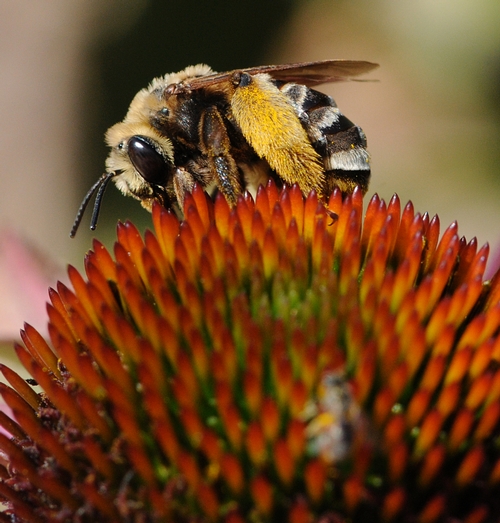
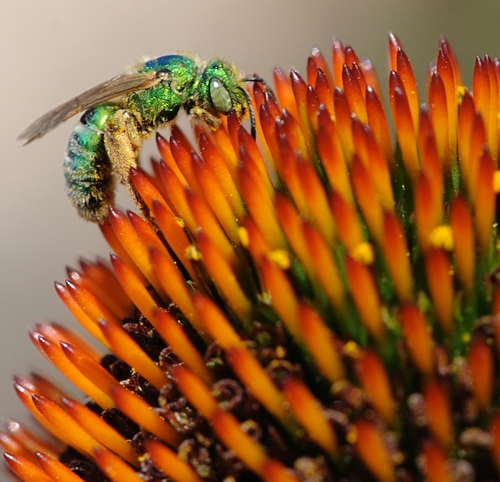
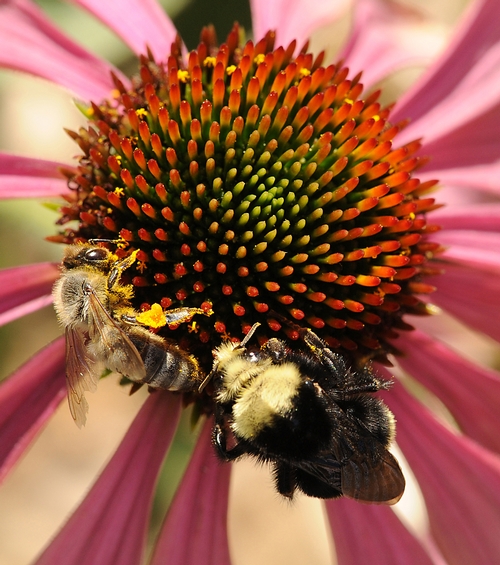
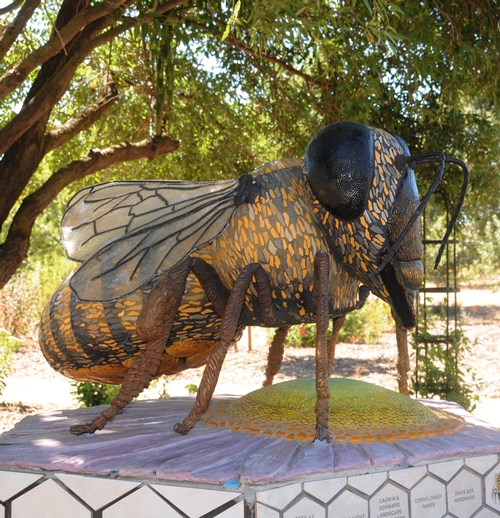
- Author: Kathy Keatley Garvey
But when a native wild bee such as the Svastra obliqua expurgata, also called "the sunflower bee," forages on a Mexican hat flower, it adds a little gaiety to the scene.
Did we just hear the Jarabe Tapatío or Mexican Hat Dance?
The scarlet red petals of the Mexican hat flower (Ratibida columnifera), droop, leaving plenty of room for dancing on the cone.
Or foraging.
This little bee (below) was foraging this week in the Häagen-Dazs Honey Bee Haven, a half-acre bee friendly garden near the Harry H. Laidlaw Jr. Honey Bee Research Facility on Bee Biology Road at the University of California, Davis.
Svastra females have dense brushes of hairs on their hind legs and transport pollen dry in these brushes (scopae), says native pollinator specialist Robbin Thorp, emeritus professor of entomology at UC Davis. Honey bees carry pollen moist on concave hair-fringed pollen baskets (corbiculae).



- Author: Kathy Keatley Garvey
Think bumble bees, carpenter bees, leafcutter bees, sweat bees, sunflower bees and scores of other bees.
The grand opening celebration of the garden will take place from 10 a.m. to 2 p.m. on Saturday, Sept. 11, but the bees and other native pollinators are already out there.
And have been for some time.
Native pollinator specialist Robbin Thorp, emeritus professor of entomology at UC Davis, has been monitoring the garden for the past two years--from open field to planted garden.
He's found more than 50 different species of bees representing five families (Andrenidae, Apidae, Colletidae, Halictidae and Megachilidae).
They include the striped sweat bee Halictus ligatus from the family, Halictidae; the yellow-faced bumble bee, Bombus vosnesenskii from the family Apidae; the leafcutter bee, Megachile sp., from the family Megachilidae; and the sunflower bee, Svastra obliqua expurgata from the family Apidae.
How colorful they are. And how diverse.
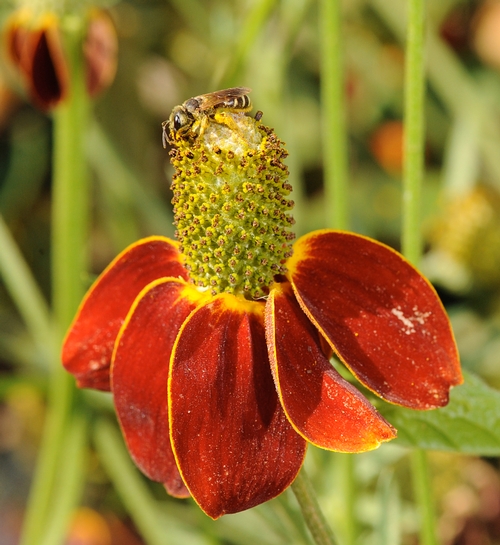
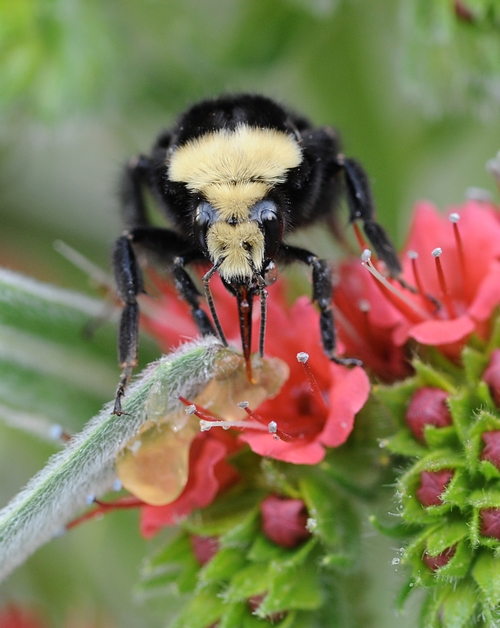
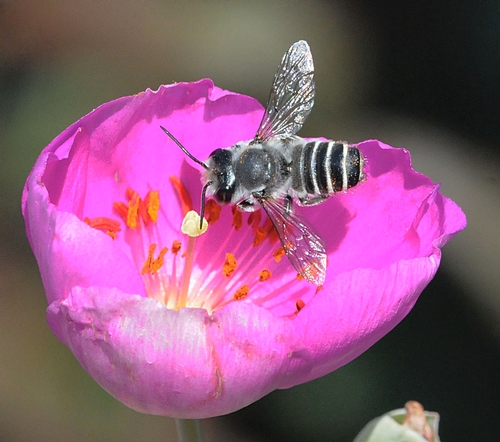

- Author: Kathy Keatley Garvey
When a sweat bee and a honey bee share the same flower, the size difference is quite distinct.
We took this photo of a honey bee on a rock purslane (Calandrinia grandiflora) blossom.
Above it stood a tiny female sweat bee (probably Halictus tripartitus, according to native pollinator specialist Robbin Thorp, emeritus professor of entomology at the University of California, Davis).
Two bees. Two sizes. One blossom. One native. One non-native. The sweat bee is a native, and the honey bee was brought over here in the 1600s by the European colonists.
Speaking of honey bees, this is the first day to participate in TwitCause. The Häagen-Dazs brand is donating $1 per Tweet (up to $500 per day) today through Nov. 11 to support honey bee research at UC Davis.
Häagen-Dazs joined forces with ExperienceProject.com (EP), a San Francisco-based online community for sharing life experiences.
Like to support honey bee research at UC Davis? Go to www.twitcause.com. Directions on top of the page detail how to follow, retweet, and help the honey bee cause on Twitter.



